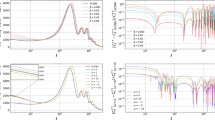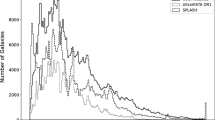Abstract
This paper presents an analysis of the smoothness problem in cosmology by focussing on the ambiguities originated in the simplifying hypotheses aimed at observationally verifying if the large-scale distribution of galaxies is homogeneous, and conjecturing that this distribution should follow a fractal pattern, in the sense of having a power-law type average density profile, in perturbed standard cosmologies. This is due to a geometrical effect, appearing when certain types of average densities are calculated along the past light cone. The paper starts by reviewing the argument concerning the possibility that the galaxy distribution follows such a scale invariant pattern, and the premises behind the assumption that the spatial homogeneity of standard cosmology can be observable. Next, it is argued that in order to discuss observable homogeneity one needs to make a clear distinction between local and average relativistic densities, and showing how the different distance definitions strongly affect them, leading the various average densities to display asymptotically opposite behaviours. Then the paper revisits Ribeiro's (1995) results, showing that in a fully relativistic treatment some observational average densities of the flat Friedmann model are not well defined at z ∼ 0.1, implying that at this range average densities behave in a fundamentally different manner as compared to the linearity of the Hubble law, well valid for z < 1. This conclusion brings into question the widespread assumption that relativistic corrections can always be neglected at low z. It is also shown how some key features of fractal cosmologies can be found in the Friedmann models. In view of those findings, it is suggested that the so-called contradiction between the cosmological principle, and the galaxy distribution forming an unlimited fractal structure, may not exist.
Similar content being viewed by others
REFERENCES
Abdalla, E., Mohayaee, R., and Ribeiro, M. B. (2001). Fractals, in press. astro-ph /9910003.
Amendola, L. 2000. Proc. of the IX Brazilian School of Cosmology and Gravitation, M. Novello, in press.
Amoroso Costa, M. (1929). Annals of Brazilian Acad. Sci. 1, 51, (in Portuguese).
Binney, J., and Merrifield, M. (1998). Galactic Astronomy, (Princeton University Press).
Bondi, H. (1960). Cosmology, 2nd ed., (Cambridge University Press).
Bonnor, W. B. (1972). Monthly Not. Royal Astron. Soc. 159, 261.
Buchert, T. (1997a). Proc. 2nd SBF Workshop on Astro-Particle Physics, Ringberg 1996, proc. series SBF375 /P002, R. Bender et al., 71, astro-ph /9706214.
Buchert, T. (1997b).Astron. Astrophys. 320, 1, astro-ph /9510056.
Buchert, T. (2000). 9th JGRG Meeting, Hiroshima 1999, invited paper, gr-qc /0001056.
Callan, C., Dicke, R. H., and Peebles, P. J. E. (1965). American J. Phys. 33, 105.
Cappi, A., Benoist, C., da Costa, L. N., and Maurogordato, S. (1998). Astron. Astrophys. 335, 779.
Charlier, C. V. L. (1908). Ark. Mat. Astron. Fys. 4, 1.
Charlier, C. V. L. (1922). Ark. Mat. Astron. Fys. 16, 1.
Coleman, P. H., and Pietronero, L. (1992). Phys. Rep. 213, 311.
Coles, P. (1998). Nature 391, 120.
Davis, M. (1997). Critical Dialogues in Cosmology, Ed.: N. Turok, (Singapore: World Scientific), 13, astro-ph /9610149.
de Vaucouleurs, G. (1970a). Science 167, 1203.
de Vaucouleurs, G. (1970b). Science 168, 917.
de Vaucouleurs, G., and Wertz, J. R. (1971). Nature 231, 109.
d'Inverno, R. (1992). Introducing Einstein' Relativity, (Oxford: Clarendon Press).
Disney, M. J. (2000). Gen. Rel. Grav. 32, 1125, astro-ph /0009020.
Ellis, G. F. R. (1971). General Relativity and Cosmology, Proc. of the International School of Physics “Enrico Fermi,” R. K. Sachs,(New York: Academic Press), 104.
Ellis, G. F. R. (2000). Gen. Rel. Grav. 32, 1135.
Ellis, G. F. R., and Rothman, T. (1993). American J. Phys. 61, 883.
Etherington, I. M. H. (1933). Phil. Mag. 15, 761; reprinted, Gen. Rel. Grav., in press.
Fournier D'Albe, E. E. (1907). Two New Worlds: I The Infra World; II The Supra World, (London: Longmans Green).
Harrison, E. R. (1993). Astrophys. J. 403, 28.
Harrison, E. R. (2000). Cosmology, 2nd ed., (Cambridge University Press).
Hogg, D. W. (1999). astro-ph /9905116.
Humphreys, N. P., Matravers, D. R., and Marteens, R. (1998). Class. Quantum Grav. 15, 3041, gr-qc /9804025.
Joyce, M., Anderson, P. W., Montuori, M., Pietronero, L., and Sylos-Labini, F. (2000). Europhys. Lett. 50, 416, astro-ph /0002504.
Keynes, J. M. (1936). The General Theory of Employment, Interest, and Money, preface.
Kristian, J., and Sachs, R. K. (1966). Astrophys. J. 143, 379.
Longair, M. S. (1995). The Deep Universe, Saas-Fee Advanced Course 23, B Binggeli and R. Buser, (Berlin: Springer), 317.
Mandelbrot, B. B. (1983). The Fractal Geometry of Nature, (New York: Freeman).
Martínez, V. J. (1999). Science 284, 445.
McCrea, W. H. (1935). Zeit. für Astrophysik 9, 290.
McCrea, W. H., and Milne, E. A. (1934). Quart. J. Math. (Oxford Ser.) 5, 73; reprinted in 2000, Gen. Rel. Grav. 32, 1949.
McVittie, G. C. (1974). Quart. J. Royal Astr. Soc. 15, 246.
Milne, E. A. (1934). Quart. J. Math. (Oxford Ser.) 5, 64; reprinted in 2000, Gen. Rel. Grav. 32, 1939.
Oldershaw, R. L. (1997). http://www.amherst.edu //rlolders /LOCH.HTM
Pan, J., and Coles, P. (2000). Monthly Not. Royal Astron. Soc., in press, astro-ph /0008240.
Peebles, P. J. E. (1980). The Large-Scale Structure of the Universe, (Princeton University Press).
Peebles, P. J. E. (1993). Principles of Physical Cosmology, (Princeton University Press).
Pietronero, L. (1987). Physica A 144, 257.
Pietronero, L., Montuori, M., and Sylos-Labini, F. (1997). Critical Dialogues in Cosmology, Ed.: N. Turok (Singapore: World Scientific), 24, astro-ph /9611197.
Pietronero, L., and Sylos-Labini, F. (2000). Proc. 7th Course in Astro-Fundamental Physics, Erice 1999, in press, astro-ph /0002124.
Ribeiro, M. B. (1992a). Astrophys. J. 388, 1.
Ribeiro, M. B. (1992b). Astrophys. J. 395, 29.
Ribeiro, M. B. (1993). Astrophys. J. 415, 469.
Ribeiro, M. B. (1994). Deterministic Chaos in General Relativity, D. Hobbil, A. Burd, and A. Coley, (New York: Plenum Press), 269.
Ribeiro, M. B. (1995). Astrophys. J. 441, 477, astro-ph /9910145.
Ribeiro, M. B. (1999). gr-qc /9910014.
Ribeiro, M. B. (2001), gr-qc /9909093.
Ribeiro, M. B., and Miguelote, A. Y. (1998). Brazilian J. Phys. 28, 132, astro-ph /9803218.
Ribeiro, M. B., and Videira, A. A. P. (1998). Apeiron 5, 227, physics /9806011.
Sandage, A. (1988). Annual Rev. Astron. Astrophys. 26, 561.
Sandage, A. (1995). The Deep Universe, Saas-Fee Advanced Course 23, B. Binggeli and R. Buser, (Berlin: Springer), 1.
Sandage, A., Tammann, G. A., and Hardy, E. (1972). Astrophys. J. 172, 253.
Sandage, A., and Tammann, G. A. (1975). Astrophys. J. 196, 313.
Schneider, P., Ehlers, J., and Falco, E. E. (1992). Gravitational Lenses, (Berlin: Springer).
Sciama, D. W. (1993). Modern Cosmology and the Dark Matter Problem, (Cambridge University Press).
Sylos-Labini, F., Montuori, M., and Pietronero, L. (1998). Phys. Rep. 293, 61, astro-ph /9711073.
Weinberg, S. (1972). Gravitation and Cosmology, (New York: Wiley).
Wertz, J. R. (1970). Newtonian Hierarchical Cosmology, PhD thesis (University of Texas at Austin).
Wertz, J. R. (1971). Astrophys. J. 164, 227.
Wu, K. K. S., Lahav, O., and Rees, M. J. (1999). Nature 397, 225, astro-ph /9804062.
Author information
Authors and Affiliations
Rights and permissions
About this article
Cite this article
Ribeiro, M.B. The Apparent Fractal Conjecture: Scaling Features in Standard Cosmologies. General Relativity and Gravitation 33, 1699–1730 (2001). https://doi.org/10.1023/A:1013095316494
Issue Date:
DOI: https://doi.org/10.1023/A:1013095316494




